Table of Contents
In the years before the construction of the transcontinental railroad by the Canadian Pacific, there was a great need for a route of travel between Southern Ontario and the northern and western areas of the province. It was inconvenient and, in some cases, impossible to travel by road and for those who did not wish to head south of the border and then west, the obvious route was up the Great Lakes.
To help fill the need for water transportation, Thomas and John J. Long in 1876, formed the Georgian Bay Navigation Company which operated steamers around Georgian Bay and up to Sault Ste. Marie, In 1880, they reorganized as the Great Northern Transit Company and this new concern absorbed the vessels and operations of the older firm. The company did well, despite the tragic loss of several vessels: WAUBUNO foundered on Georgian Bay on November 22, 1879, with the loss of thirty lives; SIMCOE sank on Lake Huron on November 24, 1880, with twelve lives lost; NORTHERN BELLE burned at Byng Inlet in 1898, and MANITOULIN burned on Manitowaning Bay on May 18, 1882, with the loss of twenty lives.
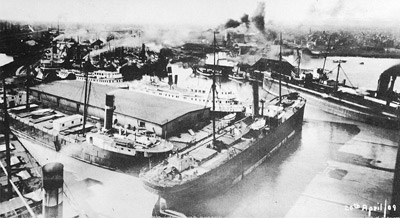
Spring fit-out at Collingwood, April 20, 1909. Group includes HAMONIC, CITY OF MIDLAND, GERMANIC, DORIC and IONIC. Courtesy of R. T. McCannell.
About 1890, the company received some competition in the form of the North Shore Navigation Company which began serving various Georgian Bay ports as well as the Soo. The company was formed by M. Burton of Barrie and W. J. Sheppard of Waubaushene. The locals came to call this fleet of steamers the "Black Line" to distinguish the ships from those of the Great Northern which was termed the "White Line", these two names being taken from the colours of the ships' hulls. Competition between the two companies soon became very hot and travellers reaped the benefits of fare-cutting and overly ambitious schedules. The "Black Line" named all its vessels after cities (or towns) of Southern Ontario, although some of the municipalities so honoured were just as diminutive as were the steamers.
Meanwhile, a third operator, older than both of these firms, was running ships on the lengthy route from Sarnia to the Canadian Lakehead. In 1865, James H. and Henry Beatty formed a partnership to operate vessels and in 1870 they established the Lake Superior Line. They incorporated as the North West Transportation Company of Sarnia in 1882, although the operation was familiarly known as the "Beatty Line." The two most famous ships of this company were the large steamers MONARCH and UNITED EMPIRE.
Early in 1899 the Beattys merged the North West Transportation Company with the Great Northern Transit Company (the White Line) to form what was known as the Northern Navigation Company of Ontario Ltd. Later in the same year, the combined companies were merged with the North Shore Navigation Company (Black Line). The result was the formation of the Norther Navigation Company Ltd., the largest firm operating in the passenger and package freight trade on the Canadian upper lakes.
For several years, the Beattys continued to operate the new company and, in fact, the firm's steamers were given the original Beatty funnel design, red with white band and black top. Control of the company passed to H. C. Hammond of Toronto by 1904. On January 31, 1911, an offer to purchase the company for the sum of $1,250,000 was advanced by James Playfair and his associates. Playfair was a vessel operator and wheeler-dealer on the grand scale. The shareholders of Northern Navigation rejected his approach but at the annual meeting on March 25, 1911, he managed to get himself elected President of the company.
No sooner had he gained control of Northern Navigation than Playfair along with G. A. Barnard of Montreal, Edmund Bristol of Toronto, and J. R. Binning of Furness Withy & Company, began negotiations to consolidate Northern Navigation and Inland Lines Ltd. (a fleet Playfair acquired in 1910 from the McKays of Hamilton) with the Richelieu and Ontario Navigation Company Ltd., a major operator of passenger and freight services on the St. Lawrence River and Lake Ontario. In February 1913, these efforts met with success and the merger paved the way for further amalgamations which, later in 1913, resulted in the formation of Canada Steamship Lines Ltd.
Northern Navigation was retained as a division of C.S.L. and its name continued to appear on the forecastles of its vessels until the close of the 1949 season when its last vessel, HURONIC, was withdrawn from service and sold for scrapping. With that move, C.S.L. retired from the Upper lakes passenger trade, although it continued to operate package freighters in the area and still does to this day, albeit on a much reduced basis.
The following steamers were all owned by the Northern Navigation Company (or Division) in the half century between its founding in 1899 and its liquidation in 1949. Vessels operated solely by predecessor companies are not included.
ATLANTIC, (a) MANITOULIN (83). (C. 85491). Wooden passenger and package freight propeller built 1880 at Owen Sound for Great Northern Transit Co. 147.0 x 30.0 x 11.0. Gross 706. Burned May 18,1882 on Manitowaning Bay, 20 lives lost. Rebuilt 1882-3 at Owen Sound by Melancthon Simpson. Gross 683, Net 442. To Northern Navigation 1899. Destroyed by fire in Georgian Bay off Pancake Islands, October 11, 1903.
BRITANNIC, (a) ROCKET (99). (C. 100188). Iron sidewheel beam-engined tug built 1866 at Glasgow, Scotland, for the Allan Line for service on the St. Lawrence between Quebec and Montreal. Appears to have been brought out in pieces, assembled at Sorel, and completed at Cantin's yard, Montreal. 150.0 x 25.0 x 13.0. Gross 590. Converted to a private yacht 1892 for Oliver Gillespie, Cornwall. 150.8 x 25.6 x 9.2. Gross 428, Net 228. Rebuilt 1895 as a passenger and freight steamer, still sidewheel, although one engine removed and placed in WHITE STAR. Purchased by Great Northern Transit Co. about 1895. To Northern Navigation 1899. Sold 1908 to Montreal & Cornwall Navigation Co. Ltd. for service between Montreal and the upper St. Lawrence. Retired at end of 1937 season and scrapped at Kingston.
CITY OF COLLINGWOOD (C. 94766). Wooden passenger and package freight propeller built 1893 at Owen Sound by Melancthon Simpson for North Shore Navigation Co. 213.0 x 34.0 x 12.6. Gross 1387, Net 893. To Northern Navigation 1899. Destroyed by fire at Collingwood, June 19, 1905.
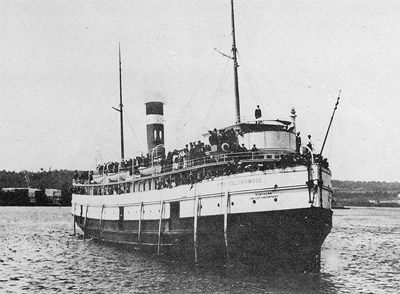
CITY OF COLLINGWOOD prepares to dock at Midland c. 1902. She burned at her namesake town in 1905. Bascom collection.
CITY OF LONDON, (a)KATHLEEN (95). (C. 92390). Wooden passenger and package freight propeller built 1888 at Kingston by Martin Clayton. 120.0 x 27.0 x 7.8. Gross 386. Rebuilt at Kingston 1892. Gross 516, Net 296. Purchased c.1892 by North Shore Navigation Co. To Northern Navigation 1899. Sold 1901 to Montreal & Cornwall Navigation Co. Ltd. Sold prior to 1914 to Achille Bernier, St. Joseph de Levis, Quebec. Dismantled 1920-21.
CITY OF MIDLAND, (C. 97111). Wooden passenger and package freight propeller built 1895 at Owen Sound by Melancthon Simpson for North Shore Navigation Co. 176.4 x 28.3 x 10.7. Gross 974, Net 662. To Northern Navigation 1899. Destroyed by fire at Collingwood, March 17, 1916.
CITY OF PARRY SOUND, (a) FAVOURITE (95). (C. 95762). Wooden passenger and package freight propeller built 1889 at Meaford for Charles A. Farrar, Meaford. 130.0 x 25.0 x 10.0. Gross 491, Net 334. Purchased 1894 by North Shore Navigation Co. To Northern Navigation 1899. Destroyed by fire at Collingwood, October 9, 1900.
CITY OF TORONTO (C. 94769). Wooden sidewheel beam-engined passenger steamer built 1895 at Owen Sound by Melancthon Simpson for North Shore Navigation Co. 150.0 x 24.0 x 9.2. Gross 782, Net 492. Appears to have been built using parts (including engine) from earlier Black Line steamer MANITOU (a) F.B. MAXWELL (90) built 1877 and dismantled at Owen Sound 1895. To Northern Navigation 1899. Sold 1908 to A. Viau, Cornwall, and operated on St. Lawrence by Montreal & Cornwall Navigation Co. Ltd. Sank at Cornwall 1914 and apparently abandoned.
DORIC (a) TADOUSAC (07). (C. 116263). Steel package freight propeller built 1903 at Toronto by Bertram Engine Works Co, Ltd. 260.0 x 43.2 x 25,2. Gross 2359, Net 1452. Apparently owned originally by Waldie & Wright (Waldie Lumber Co.) of Toronto but operated by the Hamilton and Fort William Steamship Co. (the McKays of Hamilton) under management of James Playfair. Purchased by Northern Navigation 1907. Requisitioned for salt water service 1916. Returned to C.S.L. after war but remained on salt water. Sold to French interests 1921. No record thereafter.
GERMANIC. (C. 107164). Wooden passenger and package freight propeller built 1899 at Collingwood by the Collingwood Dry Dock Co. for Great Northern Transit Co. 184.0 x 32.0 x 12.1. Gross 1014, Net 676. To Northern Navigation 1899. Destroyed by fire at Collingwood, March 30, 1917. Hull raised and lay in West Harbour for several years, then towed towards Wasaga Beach and grounded. Broken up for firewood during 1930's.
HAMONIC, (C. 122553). Steel passenger and package freight propeller built 1908-09 at Collingwood by the Collingwood Shipbuilding Co. Ltd. (Hull 22) for Northern Navigation. 349.7 x 50.0 x 32.0 Gross 5265, Net 3295. Launched November 26, 1908. Named for H. C. Hammond, President of Northern Navigation at the time of her construction. Burned at Point Edward, July 17, 1945, in fire originating on pier. No lives lost. Hull sold September to Romeo Roy, Windsor, and resold June 1946 to Steel Company of Canada Ltd. Scrapped at Hamilton 1946.
HURONIC. (C. 107168). Steel passenger and package freight propeller built 1902 at Collingwood by the Collingwood Shipbuilding Co. Ltd. Hull l) for Northern Navigation. 321.0 x 43.0 x 23.4. Gross 3330 Net 2211. Stranded August 6, 1928 on Lucille Island, Lake Superior, in most spectacular fashion as a good portion of her hull was completely out of water. Refloated ten days later and subsequently repaired. Relegated to freight-only service in late 1930's. Upper deck of passenger cabins removed 1944. Retired at end of 1949 season and sold to Steel Company of Canada Ltd. proceeded under own power to Hamilton, December 1949 and scrapped there 1950.
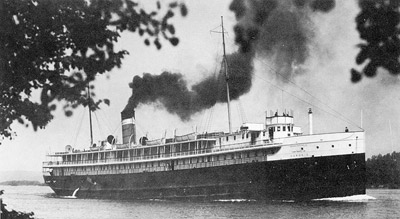
The camera of A. E. Young caught this scenic view of HURONIC on the St. Mary's River in 1916.
IONIC (20), (a) CUBA (06), (c) MAPLEBRANCH (I). (U.S. 125028 , C. 116954). Iron passenger and package freight propeller (twin screw) built 1872 at Buffalo by King Iron Works (Gibson & Craig, subcontractors) for the Commercial Line (Holt & Ensign), Buffalo. 231.7 x 35.7 x 13.3. Gross 1526, Net 1359. Sold 1884 to John Donaldson, Buffalo, and operated by the Red Star Line, Drake & Maytham managers. Sold 1906 to Northern Navigation and stripped of passenger cabins for freight-only service. 238.2 x 35.6 x 12.6. Gross 1708, Not 1030. Sank in Williamsburg Canal, St. Lawrence River, November 8, 1919. Salvaged and repaired 1920. Sold 1928 to St. Lawrence Tankers Ltd. and rebuilt as tanker at Montreal, Gross 1014, Net 634. Rammed and sunk at Montreal August 13, 1934, by H.M.S. DRAGON. Raised and rebuilt at Sorel 1935 by Les Chantiers Manseau Ltee. (later Marine Industries Ltd.) and operated by Branch Lines Ltd. until retired 1946. Lay idle at Sorel until scrapped in early 1950's.
MAJESTIC. (C. 100950). Wooden passenger and package freight propeller built 1895 at Collingwood by Collingwood Dry Dock Co. for Great Northern Transit Co. 209.0 x 35.0 x 12.6. Gross 1578, Net 1073. Launched April 23, 1895. With 800 passenger aboard, she took part in ceremonies at opening of Canadian Soo Canal, September 7, 1895. To Northern Navigation 1899. Latterly operated in Georgian Bay -Mackinac Island route. Destroyed by fire at Sarnia, Dec. 15, 1915.
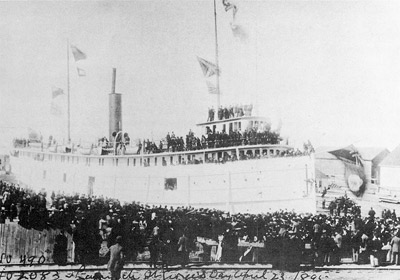
The date is April 23, 1895 and the crowd has just witnessed the launch of MAJESTIC at Collingwood.
MONARCH. (C. 96843). Wooden passenger and package freight propeller built 1890 at Sarnia by Dyble and Parry for North West Transportation Co. 245.0 x 35.0 x 15.0. Gross 2017, Net 1371. To Northern Navigation 1899. Stranded on Blake Point, Isle Royale, Lake Superior, December 6, 1906. Hull broke in two and stern dropped off into deep water. One life lost.
NORONIC. (C. 134014). Steel passenger and package freight propeller built 1913 at Port Arthur by Western Dry Dock & Shipbuilding Co. Ltd. (Hull 6) for Northern Navigation. 362.0 x 52.0 x 24.8. Gross 6905, Net 3935. Interior fittings installed at Sarnia, winter 1913-14. Finished with 5 decks rather than 4 originally planned. Entered service 1914 but during that summer took sudden and severe list while bunkering at Point Edward. Finished season but over winter 1914-15 hull was "blistered" at Detroit by Detroit Dry Dock Co. after which she had no further stability problems. Burned at Toronto in early morning hours of September 17, 1949, while on post-season excursion. 139 lives lost. Hull abandoned to underwriters as total loss. Hull raised and sold to Steel Company of Canada Ltd. Left Toronto under tow October 29, 1949, for Hamilton where scrapped.
UNITED EMPIRE (05), (b) SARONIC (17), (c) W. L. KENNEDY. (C. 80776, U.S. 215206). Wooden passenger and package freight propeller built 1882-83 at Sarnia by Dyble and Parry for North West Transportation Co. 252.8 x 36.0 x 15.0. Gross 1961, Net 1296. To Northern Navigation 1899. Familiarly known as "Old Betsy." Featured in illustration on face of 1902 Canadian $4.00 bill. Normally operating Sarnia-Lakehead, she ran briefly Montreal-Lakehead in package freight service 1913 and briefly in 1914 on Quebec-North Shore-Gulf of St. Lawrence route. Damaged at Sarnia December 15, 1915, in fire that destroyed MAJESTIC. Rebuilt 1916 as a steam barge and operated by C.S.L. in freight trade. Stranded August 20, 1916, on Cockburn Island, Lake Huron, and damaged amidships by fire which broke out after grounding. Abandoned to underwriters as total loss. Hull sold 1917 to U. S. interests and rebuilt as tow barge registered at Marquette, Michigan. Gross 1014, Net 1014. Used to carry pulpwood for Detroit Sulphite Co. Abandoned 1924 in Detroit River near Amherstburg.
WAUBIC (38), (b) ERIE ISLE (43), (c) PRINCE NOVA. (C. 122555). Steel passenger propeller (twin screw) built 1909 at Collingwood by Collingwood Shipbuilding Co. Ltd. for Northern Navigation. 134.1 x 25.0 x 9.5. Gross 504, Net 244. Designed as day-boat for Georgian Bay service and built with wood-sheathed hull for protection of plating in shallow waters with rocky bottom. Usually operated Midland-Parry Sound. Sold 1922 to Rockport Navigation Co. Ltd., Kingston, and operated in Thousand Islands excursion trade. Sold 1934 to A.R. and V.C. Irvine, Port Arthur, and operated between Port Arthur and Silver Islet. Sold 1937 to Capt. J. Earl McQueen, Amherstburg, and operated Kingsville-Leamington-Pelee Island on Lake Erie, Damaged by fire at Kingsville, January 18, 1938. Rebuilt 1938 at Muir Bros. Drydock, Port Dalhousie, and repowered with Fairbanks-Morse diesels. 135.3 x 25.0 x 8.2. Gross 451, Net 297. Sold 1943 to Northumberland Ferries Ltd., Charlottetown, and taken to east coast for ferry service to Prince Edward Island. Destroyed by fire at Pictou, Nova Scotia, July 6, 1959.
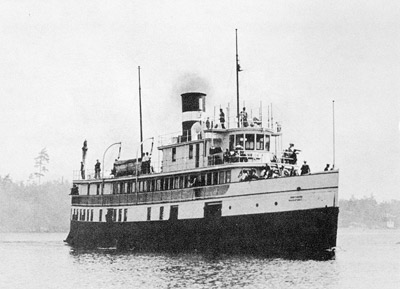
A rare photo of WAUBIC shows her negotiating a narrow Georgian Bay channel. Courtesy Don McCartney.
In addition to the vessels already listed, the following steamers are known to have been operated by Northern Navigation in various services over the years:
BROCKVILLE, (b) NORA H. (C. 107421). While owned by C.S.L. was apparently operated in Northern Navigation Division for Georgian Bay service.
CITY OF WINDSOR (II) (11), (a) E. K. ROBERTS (90), (0) MICHIPICOTEN. (C.94843) Chartered by Northern Navigation 1906 for Georgian Bay service.
LOUIS PHILIPPE, (b) JOSEPH DUBRULE. (C. 134491). Ferry owned by C.S.L. Operated by Northern Navigation for several years from 1923 in Port Huron-Sarnia ferry service.
MAPLEBORO (23), (a) SEGUIN (20), (c) CITY OF MONTREAL (II) (26), (d) ARVIDA. (c. 94763). Owned by C.S.L., was used in Northern Navigation freight service Sarnia-Lakehead during early 1920's.
RAPIDS KING. (C. 122407). Taken from C.S.L. fleet for operation on Northern Navigation route Detroit-Wallaceburg during 1920's.
ROCHESTER (20), (b) CAPE ETERNITY (35), (c) GEORGIAN (41), (d) AVALON II (45) (e) GEORGIAN (46), (f) HASIN. (U. S. 207073, C. 141863). Taken briefly from C.S.L. fleet prior to 1920.
THOUSAND ISLANDER. (U. S. 209906, C. 141756). Taken from C.S.L. fleet for operation on Northern Navigation route Detroit-Wallaceburg, 1918-1927.
When Northern Navigation was formed in 1899, it operated two basic services, the run to the Lakehead from Sarnia (maintained by the Beatty boats MONARCH and UNITED EMPIRE) and the multitude of runs from Collingwood to other Georgian Bay and North Shore ports, Manitoulin Island, Mackinac Island, and Sault Ste. Marie, these chores being handled by the smaller ships of the fleet. Business at Collingwood soon decreased sufficiently that in 1909 the head office of the company was moved to Sarnia and from then on the Sarnia-Lakehead route was the main concern, only incidental services (such as the Parry Sound day route) being maintained in Georgian Bay. The Georgian Bay operations were finally closed out in 1922 with the sale of WAUBIC. Meanwhile, the upper lakes passenger and freight service had been extended at either end of the Sarnia-Lakehead run with the addition of calls at Windsor and Duluth. The big three, HURONIC, HAMONIC and NORONIC, were to maintain this same route until the end of their days.
As a postscript to the history of the Northern Navigation Company, it is interesting to note the great number of ships in the fleet that met violent ends. Of the 17 steamers owned by the company over a half century, one (MONARCH) met a violent death by stranding, while nine went out by the "fire route". In the case of the older wooden vessels, destruction by fire was not entirely unexpected, although the scourge of fire seemed to hit Northern Navigation vessels with alarming frequency. But the loss of the company's two largest and finest steamers, HAMONIC and NORONIC, by this peril has proven to be one of the most tragic chapters in the story of Canadian lake navigation.
Previous Next
Return to Home Port or Toronto Marine Historical Society's Scanner
Reproduced for the Web with the permission of the Toronto Marine Historical Society.